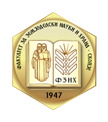THE ABBREVIATED WOMEN’S EMPOWERMENT IN AGRICULTURE INDEX: AN APPLICATION IN THE REPUBLIC OF NORTH MACEDONIA
Keywords:
gender equality, agriculture, women’s empowerment.Abstract
Gender inequality has important implications for any society and is particularly important for developing economies because of their large reliance on the agricultural sector where it is especially pronounced. Women are often a crucial resource in agriculture and the rural economy but face constraints that reduce their productivity and hinder their competitiveness in the sector. In this study we measure the Abbreviated Women’s Empowerment in Agriculture Index, as a standardized methodology that directly capture women’s empowerment and inclusion of women in the agricultural sector, and quantify the level of women empowerment in the agricultural sector in the Republic of North Macedonia. Results show that women are disempowered in all domains in agriculture compared to men. More precisely, women are significantly disempowered in ownership of assets, input in decision making and control over use of income. Positive impact on the higher empowerment of the households and smaller gender parity gap is when women are responsible for farm accountancy within the agricultural household.
References
Alkire, S., Meinzen-Dick, R., Peterman, A., Quisumbing, A., Seymour, G., & Vaz, A. (2013). The Women's
Empowerment in Agriculture Index. World Development, 52, 71-91.
Almas I., Armand A., Attanasio O., Pedro C. (2018). Measuring and Changing Control: Women's Empowerment
and Targeted Transfers. The Economic Journal, Feature: Improving productivity in developing countries,
Volume 128, Issue 612, F609–F639.
Engel, C. (2011). Dictator Games: A Meta Study. Experimental Economics, 14(4), 583–610.
FAO. (2018). Empowering rural women, powering agriculture. Rome: FAO.
Forsythe, R., Horowitz, J., Savin, N., & Sefton, M. (1994). Fairness in Simple Bargaining Experiments.
Fox, L., & Romero, C. (2017). In the mind, the household or the market? Concepts and measurement of women’s
economic empowerment. Policy Research Working Papers Series 8079, World Bank.
Jakјimovski J., & Matilov N. (2002). Social structure of the village. Institute for Sociological, Political and
Juridical Research, Skopje.
Malapit, H., Kovarik, C., Sproule, K., Meinzen-Dick, R., & Quisumbi, A. (2015). Instructional Guide on the
Abbreviated Women’s Empowerment in Agriculture Index (A-WEAI). United States Government’s Feed the
Future Initiative, International Food Policy Research Institute.
Risteska, M., Lazarevski, G., & Mickovska-Raleva, A. (2012). Perspectives of women in rural areas, Baseline
study of the status and livelihoods of women in rural areas. Skopje: Center for Research and Policy Making.
Tuna, E., & Petrovska-Mitrevska, B. (2017). Multidimensional poverty analysis, Project Institutional support of
FFRM. Skopje: We effect - Swedish Cooperation Centre.
Yount, K., VanderEnde, K., Dodell, S., & Cheong, Y. (2016). Measurement of Women’s Agency in Egypt: A
National validation study. Social Indicator Research, Springer, 128(3), 1171-1192.



